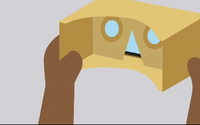
Immersive content, drone footage, virtual and augmented reality are among
the hottest topics in advertising, yet many in the industry only have surface knowledge. They remain unaware how to effectively approach this space.
To address this, Horizon
Media’s New York City office hosted its first DSCVR: Virtual Reality Summit earlier this week. More than 300 Horizon clients and employees were immersed in VR specifics, marketing
opportunities and best practices.
Tanvir Hannan, the agency’s head of conversations, Why Group, kicked off the event with an overview of the Virtual Reality landscape. He shared insights
on consumer trends and behaviors surrounding VR, and explained how marketers can leverage VR technologies to reach consumers.
Hannan told attendees that marketers must consider VR as either a
"portal for entertainment or a utilitarian tool" that makes consumers’ lives easier, in order to effectively use this technology. VR requires marketers to rethink media and focus sharply on
immersive experiences versus trying to retrofit VR into existing campaigns.
advertisement
advertisement
Donnie Williams, chief digital officer, Horizon, moderated the panel “The Future of Storytelling”
with Monika Ratner, Horizon’s director, social media and invention; Tony Mugavero, founder/CEO, Littlstar; Jenna Pirog, virtual reality editor, The New York Times; and Pete
Jones senior producer at Framestore’s VR Studio in New York.
The panelists touched on 360-video, which is not technically VR, but serves as a "gateway drug" for VR because it’s
more easily accessible and more affordable to produce. Mugavero shared that there will always be a spectrum of consumption from passive -- known as 360 video -- to active, which is VR.
Mugavero
and Pirog cautioned that although 360-video has allowed brands to create affordable 360 experiences using highly visual content, it should be approached differently.
For example, Pirog noted
that rapid movements in 360 video might induce vertigo and make some viewers “puke.”
Williams approached the panel from the view of a skeptic: if VR is considered another
form of media, is there even a place for it? He wondered. Mugavero acknowledged that it is hard to change people’s behaviors. We are used to going home and watching Netflix rather than
going home and putting on a VR headset. “This is the challenge the VR industry is faced with-- how do we give people a reason utilize VR?”
Meanwhile, slang matters.
Jones
explained that we are still trying to understand the language, which is fundamental at this point in the development of the technology. From a journalism standpoint, Pirog agreed that there is
undoubtedly room for VR as an additional form of media; in fact at The New York Times, it has its own category.
“The storytelling potential that VR holds for journalism is
huge, and we are slowly experimenting with what stories work best with this technology,” she said.
The Times’ efforts in the VR arena were recognized at Cannes, where it
(along with partners it worked with) won multiple Lions for a VR-capable app
and a piece of VR journalism shot for that app.
Another topic broached was the need for better metrics in the VR space. Currently heat maps can detect where viewers are looking while using VR,
and engagement times can be measured, but marketers will want more data when investing in VR technology, the panelists said.
Williams asked the panel to offer suggestions for ways a
marketer today can use VR tech effectively. Ratner proposed that two of the most feasible ways for marketers is 360-video production (which people find comfortable and accessible), and incorporating
VR into event experiences.
Hannan added that VR must serve a purpose for marketers and not just be used for the sake of using it.
As to when VR might reach some kind of scale, the panel
unanimously agreed that it would happen when mass-produced and affordable viewing devices are available and importantly, are easy to plug and play with instant syncing with existing platforms and
products.
Ratner stated that VR has been looked at as an isolated experience, adding however that “we will see it ultimately become more of a social experience in the
future.” Pirog voiced concerns about people falling over or hitting furniture while using VR at home, and envisions the future of VR as a sensory experience in movie theater-like
situations.
Mugavaro concluded by saying he is looking forward to when VR moves from being seen as an entertainment device to a part of our everyday lives.
The agency's Los
Angeles' office plans to host a similar event in the coming months.